Final Statistical Monitoring Report on the Implementation of China National Program for Women’s Development (2011-2020)
National Bureau of Statistics
December 2021
In order to protect women's rights, promote women's development, and advance equality between men and women, the China National Program for Women’s Development (2011-2020) was promulgated and implemented in 2011, hereinafter referred to as the NPA for Women. Recently, the National Bureau of Statistics conducted the final statistical monitoring of the implementation of the NPA for Women in seven areas including health, education, economy, decision-making and management, social security, environment and law based on the relevant statistics and monitoring data on the NPA for Women indicators. The results show that key targets of the NPA for Women have been achieved as planned. Over the past 10 years, women's social status has significantly improved, historic achievements have been made in promoting gender equality and women's all-round development, and women's sense of gain, happiness and security have significantly increased. However, imbalanced and insufficient women’s development is still prominent, and the protection of women's rights and interests still needs to be further strengthened in relevant areas.
I. Achievements of the NPA for Women in Seven Areas
1. Women and Health
1.1) The average life expectancy among women exceeded 80 years. Since China became one of the countries with high life expectancy [1] in 2000, the average life expectancy in the country has continued to increase. The average life expectancy of women has increased from 77.37 years in 2010 to 79.43 years in 2015, and further increased to 80.88 years [2] in 2020. According to the estimation of the United Nations’ World Population Prospects, the average life expectancy of women in China ranked 62nd among 184 countries in 2020, which is 4 years higher than the global average life expectancy of women.
1.2) The maternal mortality ratio decreased by more than 40%. Since the implementation of the NPA for Women, on the basis of safeguarding maternal and child health, China has actively promoted comprehensive health services for women and children. The maternal mortality ratio (MMR) has continued to decline, and the health of women and children has significantly improved. In 2020, China's MMR was 16.9 per 100,000 live births, which was 43.7% lower than that in 2010, and ranked high among middle and high income countries in the world. The MMRs were 14.1 per 100,000 live births in urban areas and 18.5 per 100,000 live births in rural areas, which were 52.5% and 38.5% lower than that in 2010 (see Figure 1), respectively.
Figure 1. Maternal Mortality Ratio, 2010-2020
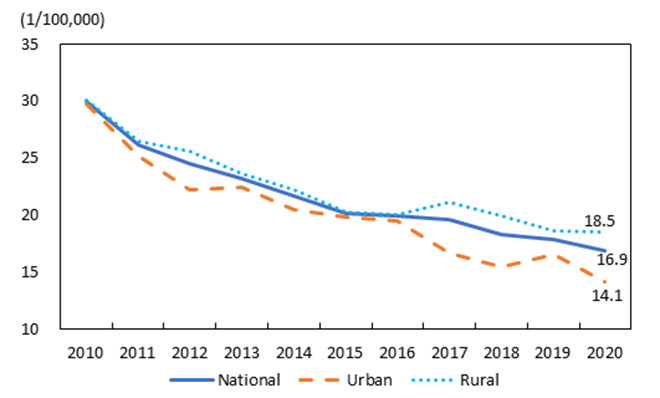
1.3) The capacity for delivering maternal and child health services has significantly improved. Since the implementation of the NPA for Women, China's maternal and child health service content has continuously expanded, and the capacity for delivering these services has steadily improved. In 2020, there were 3,052 maternal and child health institutions; there were 807 maternity hospitals, which was twice the number in 2010; and there were 285 thousand obstetricians and gynecologists [3], an increase of 55.7% since 2010[4]. The hospital delivery rate has remained above 99% since 2012. It was 99.9% in 2020, an increase of 2.1 percentage points from 2010. The systematic management rate for maternal care was 92.7%, an increase of 8.7 percentage points since 2010, significantly higher than the 85% target outlined in the NPA for Women. In 2020, the antenatal care coverage and postnatal care coverage were 97.4% and 95.5%, respectively, an increase of 3.3 and 4.7 percentage points from 2010.
1.4) Women's reproductive health services have significantly improved. Since the implementation of the NPA for Women, the free pre-pregnancy health check has been fully implemented, and awareness on pre-pregnancy risk factor prevention has steadily improved. Reproductive health knowledge has been substantially promoted, and women's self-care awareness and capacity have greatly improved. In 2020, free pre-pregnancy health check were provided to 8.67 million persons planning for pregnancy, achieving an average coverage rate of 96.4% for the target population. All at-risk individuals identified through the health check also received targeted services including consultation, guidance, treatment and referral. In 2020, the screening rate of common diseases among women reached 86.6%, an increase of 25.4 percentage points from 2010, and achieving the over 80% target outlined in the NPA for Women (see Figure 2).
Figure 2. Screening Rate of Common Diseases Among Women, 2010-2020
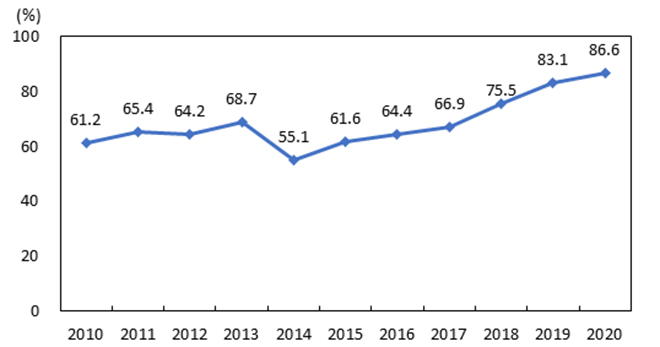
2. Women and Education
2.1) Equal access to pre-primary education for girls has been effectively guaranteed. Since the implementation of the NPA for Women, China has successively implemented three action plans on pre-primary education, increased pre-primary education resources through various channels, and effectively guaranteed the right to equal access to pre-primary education for girls. In 2020, 22.72 million girls were enrolled in pre-primary education (including kindergartens and pre-primary classes attached to schools) across the country, an increase of 9.19 million girls or 68% since 2010, and the growth rate was 6.1 percentage points higher than that of all children enrolled in pre-primary education. Of all children receiving pre-primary education, the proportion of girls was 47.2%, an increase of 1.7 percentage points from 2010 (see Figure 3). By 2020, the national gross enrollment ratio for pre-primary education was 85.2%, far higher than the 70% target outlined in the NPA for Women.
Figure 3. Number and Proportion of Girls in Pre-primary Education, 2010-2020
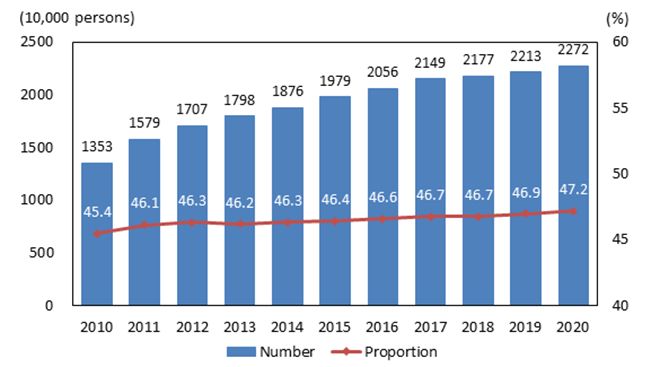
2.2) The gender gap in compulsory education has been basically eliminated. Since the implementation of the NPA for Women, with the progress in urban-rural integration and the continuous improvement of relevant laws and policies, and the implementation of special support policies for girls such as the Spring Bud Program, girls' right to equal access to compulsory education has been further guaranteed. The net enrollment rate of primary school-age girls remained above 99.9% for six consecutive years since 2015, which was virtually the same as that of boys. The gender gap in compulsory education has been essentially eliminated. In 2020, the survival rate of the nine-year compulsory education was 95.2%, an increase of 4.1 percentage points from 2010, and achieved the 95% target outlined in the NPA for Women as planned. There were 72.85 million female students enrolled in the nine-year compulsory education stage, an increase of 1.97 million or 2.8% since 2010, accounting for 46.6% of the total number of students in school.
2.3) Equal access to senior secondary education [5] has been strengthened for girls. Since the implementation of the NPA for Women, the level of universalization of senior secondary education in China has continuously advanced, and the equal access to senior secondary education for girls has further strengthened. In 2020, the gross enrollment ratio of senior secondary education across the country reached 91.2%, an increase of 8.7 percentage points from 2010, and achieved the 90% target outlined in the NPA for Women. In 2020, there were 19.50 million girls enrolled in senior secondary education, accounting for 46.9%. Among them, 12.58 million girls were enrolled in regular senior secondary schools, accounting for 50.4%. This figure has remained above 50% for six consecutive years.
2.4) The proportion of girls surpassed the proportion of boys in all forms of higher education. Since the implementation of the NPA for Women, China’s higher education has developed rapidly, and the opportunities for women to receive higher education have continued to increase. Financial assistance has been provided to poor female students and female students with disabilities via multiple channels and methods, thus effectively guaranteeing women's equal access to higher education. In 2020, the gross enrollment ratio of higher education was 54.4%, an increase of 27.9 percentage points from 2010. There were 1.60 million female graduate students enrolled in higher education, accounting for 50.9% of all graduate students, and an increase of 3.1 percentage points from 2010 (see Figure 4). The number of female students enrolled in colleagues/universities and adult programs in colleges/universities were 16.74 million and 4.51 million, respectively, accounting for 51.0% and 58.0% of all undergraduate students, an increase of 0.1 and 4.9 percentage points from 2010.
Figure 4. Number and Proportion of Female Students in Graduate Education, 2010-2020
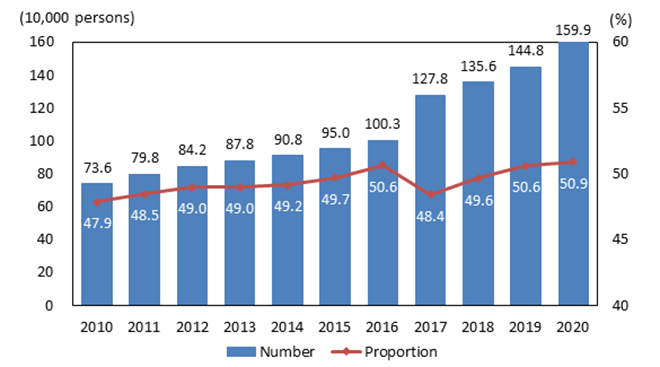
2.5) The gender gap in the average level of education has further narrowed. According to the results of the Seventh National Population Census, the average number of years of education received by the population aged 15 and above in 2020 was 9.91 years, which was 10.22 years for men and 9.59 years for women. Compared to 2010, the gender gap has narrowed from a difference of 0.8 years to a difference of 0.6 years. The national crude illiteracy rate [6] was 2.67%. The crude illiteracy rate of women was 4.10%, 2.1 percentage points lower than that in 2010. Compared to 2010, the gender gap has narrowed from a difference of 4.1 percentage points to a difference of 2.8 percentage points.
3. Women and the Economy
3.1) Women account for over 40% of the employed population. Since the implementation of the NPA for Women, policies supporting employment and entrepreneurship have gradually improved, employment channels for women have continuously expanded, and the number of women employed has increased steadily. In 2020, there were 67.79 million female workers in urban work units, an increase of 19.18 million or 39.5% from 2010. The proportion of women in the total employed population was 43.5%, achieving the 40% target outlined in the NPA for Women.
3.2) Labor protection for female employees has been actively strengthened. The Special Provisions on Labor Protection for Female Employees (hereinafter referred to as the Special Provisions), promulgated and implemented since 2012, has promoted the continuous improvement of the working conditions for female employees and effectively safeguarded the legal rights and interests of women in the workforce. In 2020, the proportion of enterprises [7] in China implementing the Special Provisions reached 71.3%, an increase of 16.4 percentage points from 2010.
3.3) Poverty alleviation for women in rural areas has achieved a complete victory. After persisting efforts, China has lifted all rural poverty population and all designated poverty counties out of poverty. In particular, the issues of “Two Assurances and Three Guarantees” have been fully realized for populations lifted out of poverty, including women. By the end of 2020, women accounted for about half of the nearly 100 million people lifted out of poverty.
3.4) Government’s support for poor women has been continuously strengthened. Since the implementation of the NPA for Women, China has successively introduced a series of policies and measures to expand employment channels for women, improve their skill levels and strengthen their health protection, providing robust support for the poverty alleviation and sustainable development of poor women. In 2020, the average standard of the minimum subsistence allowance (Dibao) in urban and rural areas was RMB 677.6 and RMB 496.9 per month, respectively, which were 2.7 times and 4.2 times that of 2010. The number of urban and rural recipients of Dibao and the number of rural people living in extreme difficulties totaled 48.72 million, of which 20.95 million were women, accounting for 43.0% and an increase of 9.1 percentage points from 2010.
4. Women’s Participation in Decision-making and Management
4.1) The proportion of female delegates of the National People’s Congress (NPC) and female members of the Chinese People’s Political Consultative Conference (CPPCC) reached the highest in history. Since the implementation of the NPA for Women, China has actively promoted and supported women's participation in politics. The proportion of women in decision-making and management has increased significantly, and women's political rights have been effectively safeguarded and strengthened. In 2018, the 13th session of the NPC had 742 female delegates, accounting for 24.9% of the total number of delegates, and 3.6 percentage points higher than the 11th session (2008). This was the NPC session with the highest proportion of female delegates in history (see Figure 5). In the same year, the 13th session of the National Committee of the CPPCC had 440 female members, accounting for 20.4% of the total number of members, an increase of 2.7 percentage points since the 11th session (2008). Similarly, this was the CPPCC session with the highest proportion of female members in history (see Figure 5).
Figure 5. Proportion of Female NPC Delegates and Female CPPCC Members
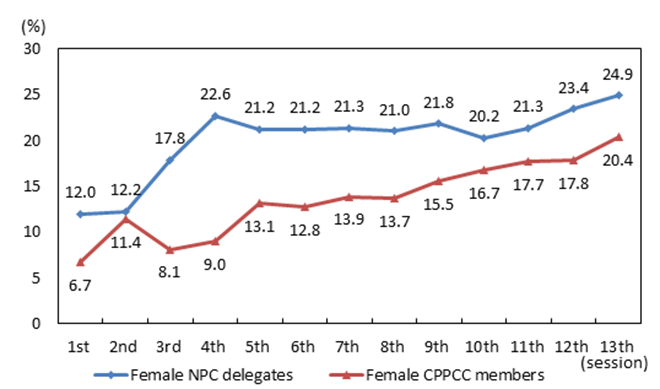
4.2) Women's participation in business management has expanded. Since the implementation of the NPA for Women, China’s economic and social development has been accelerated, societal beliefs and perceptions have been changing, and the open, transparent, and merit-based selection and appointment mechanism has continuously improved. Women are occupying an increasingly important position in business management. In 2020, the proportion of females on the boards of directors and boards of supervisors of enterprises were 34.9% and 38.2%, respectively (see Figure 6), an increase of 2.2 and 3.0 percentage points since 2010. The proportion of female representatives in the workers’ congress of enterprises [8] was 30.2%, an increase of 1.2 percentage points from 2010.
Figure 6. Proportion of Females on Boards of Directors and Boards of Supervisors of Enterprises, 2010-2020
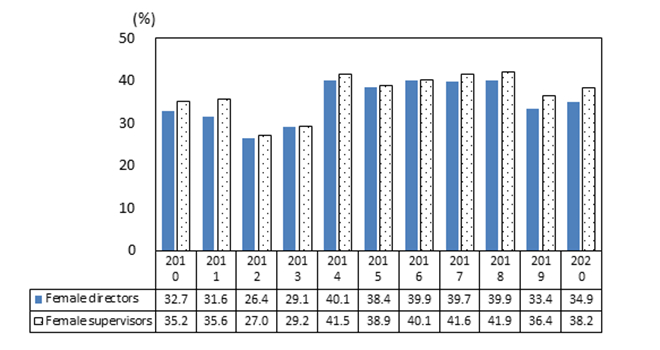
4.3) Women's participation in democratic governance at the grassroots level has expanded. Since the implementation of the NPA for Women, women have actively participated in social governance at the grassroots level, and the proportions of female members in residents’ committees and villagers’ committees have increased. The proportion of female members in residents’ committees remained at about half and reached 52.1% in 2020, an increase of 2.5 percentage points from 2010, achieving the “around 50%” target outlined in the NPA for Women. The proportion of female members in villagers’ committees was 24.2%, an increase of 2.8 percentage points from 2010.
5. Women and Social Security
5.1) Maternity insurance [9] coverage has significantly expanded. During the implementation of the NPA for Women, a comprehensive maternity protection system has been gradually established. The joint implementation of maternity insurance and medical insurance for employees was comprehensively promoted, and it significantly enhanced the co-financing capacity of government funds. Maternity medical expenses of unemployed women were reimbursed through the basic medical insurance for urban and rural residents, achieving full coverage of maternity medical expenses for all women. At the end of 2020, 103 million women participated in maternity insurance, an increase of 49.31 million or 1.9 times that of 2010 (see Figure 7).
Figure 7. Number of Women Participating in Maternity Insurance, 2010-2020
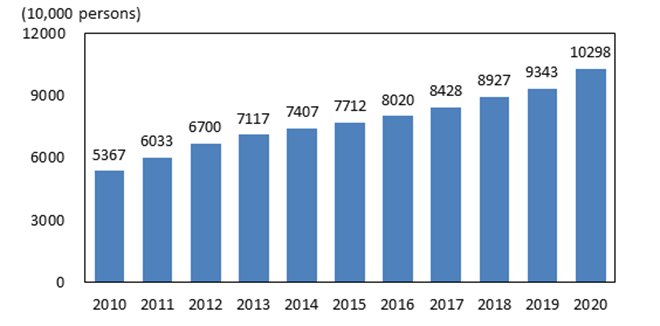
5.2) The number of women participating in medical insurance has increased significantly. In recent years, on the basis of realizing full coverage of basic medical insurance for urban and rural women, China integrated the basic medical insurance schemes for urban and rural residents, improved the medical assistance and supplementary medical insurance schemes in urban and rural areas, and further advanced the multi-level medical security system, enabling more women to enjoy equitable medical protection. At the end of 2020, 650 million women participated in basic medical insurance, 3.4 times that of end 2011 [10]. Among them, 160 million women participated in basic medical insurance for urban employees, an increase of 58.02 million or 55.1% from end 2010. A total of 490 million women participated in basic medical insurance for urban and rural residents, an increase of 410 million or 6.5 times that of end 2011.
5.3) Women entitled to basic pension insurance were largely covered. Since the implementation of the NPA for Women, the reform of China’s pension insurance scheme has continuously progressed. An integrated pension insurance scheme for urban and rural residents was established to cover age-appropriate urban and rural residents who have not participated in basic pension insurance for urban employees, highlighting the principle of inclusiveness and ensuring minimum guarantee. According to incomplete statistics, at the end of 2020, 470 million women participated in basic pension insurance [11], an increase of 120 million from end 2016 [12]. Among them, 210 million women participated in basic pension insurance for urban employees, an increase of 96.55 million or 86.2% since end 2010. A total of 260 million women participated in basic pension insurance for urban and rural residents, an increase of 91.70 million or 53.8% from end 2016.
5.4) The number of women participating in unemployment insurance and work-related injury insurance has increased by about 80%. Since the implementation of the NPA for Women, China implemented the unemployment relief scheme, the state-owned enterprise unemployment insurance scheme, the basic livelihood guarantee for laid-off workers scheme, and the unemployment insurance scheme to effectively protect the employment rights and interests of women. At the end of 2020, 92.07 million women participated in unemployment insurance, an increase of 40.58 million or 78.8% since end 2010. A total of 103 million women participated in work-related injury insurance, an increase of 45.71 million or 80.2% from end 2010.
6. Women and the Environment
6.1) The ecological environment has been significantly improved. With the deepening notion that “clear waters and green mountains are as valuable as mountains of gold and silver”, the extent of green and low-carbon production and lifestyle in China has increased significantly, with the total emission of major pollutants drastically reduced and the stability of the ecosystem enhanced. At present, 12 thousand protected areas of varying levels and types have been established across the country with national parks at its core. The protected areas account for 18% of the country’s total land area. According to data from the 9th National Forest Resources Inventory (2014-2018), China’s forest area exceeded 220 million hectares, an increase of 12.76 million hectares from the 8th National Forest Resources Inventory (2009-2013); and the forest coverage rate was 22.96%, an increase of 1.33 percentage points.
6.2) The urban environment has been continuously improved. In recent years, with increasing efforts to develop the urban environment, the appearance of urban environments across the country has significantly improved, and the sense of gain in ecological environment among residents has greatly enhanced. In 2020, the per capita park and green space in urban areas across the country was 14.8 square meters, an increase of 3.6 square meters from 2010. The greenery coverage of urban built-up areas, the urban sewage treatment rate, and the rate of harmless disposal of household solid waste in urban areas were 42.1%, 97.5%, and 99.7%, respectively, which were 3.5, 15.2, and 21.8 percentage points higher than that in 2010. In 2020, the annual average concentration of fine particulate matter (PM2.5) in 337 cities at or above the prefecture level was 33 micrograms/m3, which was lower than the level II national standard (35 micrograms/m3) for the first time.
6.3) The living environment in rural areas has continued to improve. In 2018, 18 ministries including the Leading Group Office of Rural Work jointly issued the Rural Living Environment Improvement and Clean Village Action Plan, and initiated and implemented key actions related to improving the environment in villages. At present, the objectives and tasks outlined in the three-year action plan on rural living environment improvement have been fully achieved, and more than 95% of villages in the country have carried out the relevant key actions. The environmental and health awareness among rural residents were further enhanced, and the living environment in rural areas became clean and tidy. In 2020, 88.0% of residents were benefiting from centralized water supply in rural areas, an increase of 30 percentage points since 2010, achieving the “around 85%” target outlined in the NPA for Women (see Figure 8).
Figure 8. Proportion of Rural Population Benefiting from Centralized Water Supply, 2010-2020
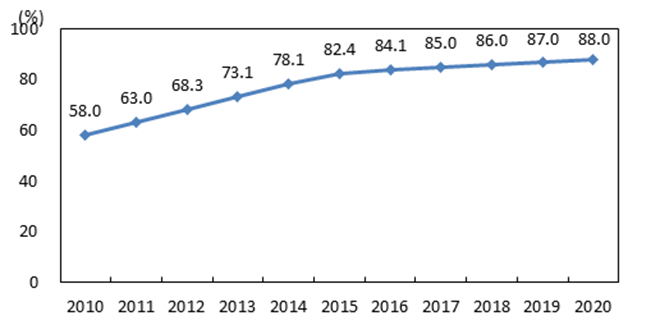
6.4) Full coverage of community service facilities achieved in urban areas. In recent years, relevant departments have vigorously promoted the establishment of community services, with public and commercial services for the convenience and benefit of community residents universally available. At the end of 2020, there were 802 thousand community service institutions and facilities across the country, an increase of 441 thousand from end 2015 [13]. In 2020, the coverage rate of comprehensive community service facilities in urban and rural areas reached 100% and 65.7%, respectively, an increase of 20.7 and 51.4 percentage points compared with 2016 [14]. The living and development environment of all populations including women have continued to improve, and daily life has become more convenient.
7. Women and the Law
7.1) The relevant legal and regulatory systems have steadily improved. Since the implementation of the NPA for Women, China has continuously strengthened the protection of the rule of law for gender equality. At present, there is an established legal system to protect women's rights and promote gender equality. This legal system is based on the Constitution, with the Law on the Protection of Women's Rights and Interests at its core, and supplemented by various national laws and local regulations. The promulgation and revision of laws and regulations, such as the Civil Code, the Labor Contract Law, the Election Law, the Organizational Law of Villagers’ Committees, the Land Contract in Rural Areas Law, the Law on the Protection of Women’s Rights and Interests and the Special Provisions on the Labor Protection of Female Employees, provide clear stipulations for women’s property rights, legal rights of female employees, women’s land contracting rights, and health rights of female employees. This system of laws and regulations for safeguarding women's rights and gender equality continues to be improved. Significantly, the Standing Committee of the 12th NPC passed the Anti-Domestic Violence Law in 2015, marking the official inclusion of domestic violence in the scope of legal supervision. This was an important milestone for the condemnation of domestic violence and the protection of women, children and other vulnerable groups.
7.2) Remarkable results have been achieved in cracking down on the trafficking of women. In order to effectively crack down on the trafficking of women and diligently protect the legal rights and interests of women, China issued its second anti-trafficking action plan, titled the National Plan of Action on Combatting Human Trafficking (2013-2020), and resolutely cracked down on the trafficking of women in accordance with the law, increased the rectification of the "buyer's market" for human trafficking, and reduced the occurrence of human trafficking cases at its source. As a result, the trafficking of women has been effectively curbed.
7.3) Legal aid support to women has been greatly strengthened. By the end of 2020, there were 2,651 legal aid institutions and 75 thousand legal aid stations across the country. In 2020, legal aid services were provided 341 thousand person-times to women, an increase of 73.7% since 2010. From 2011 to 2020, legal aid services were provided a total of 3.31 million person-times to women across the country. In 2020, women's federations at or above the county level responded to complaints from women and children a total of 188 thousand times.
II. Key Challenges during the Implementation of the NPA for Women
1. Uneven and inadequate development of women’s health still exists.
Although the health status of women in China has greatly improved, there are still gaps between urban and rural areas. In 2020, the MMR in rural areas was 18.5 per 100,000 live births, a decrease by 38.5% compared with 2010, but still higher than that in urban areas (14.1 per 100,000 live births).
2. Rural women's participation in social affairs management needs to be strengthened
Since the implementation of the NPA for Women, women have actively participated in social governance at the grassroots level, but compared with urban areas, the level of rural women's participation needs to be further improved. In 2020, the proportion of female members in villagers’ committees was 24.2%, which was still far from the “30% or more” target outlined in the NPA for Women.
Notes:
1. According to the standards set by the World Health Organization, countries with an average life expectancy of more than 70 years are considered high life expectancy countries.
2. This is based on data from the Seventh National Population Census.
3. The number of obstetricians and gynecologists refers to the number of registered physicians (and assistants) in the obstetrics and gynecology departments and women’s health departments.
4. The total numbers and percentages presented may have calculation errors due to the use of different units of measurement, and no manual adjustments have been made.
5. The senior secondary education stage includes regular senior secondary school, senior secondary school for adults, regular and adult specialized secondary education, senior secondary vocational school, and vocational-technical school.
6. The illiteracy rate refers to the proportion of the illiterate population aged 15 and above in the total population.
7. This refers to an enterprise with an established a trade union.
8. The proportion of females on the boards of directors and boards of supervisors of enterprises, and the proportion of female representatives in workers’ congresses of enterprises are based on the relevant data from enterprises that have established trade unions in the country.
9. According to the law, maternity insurance covers both the employer and the employee.
10. The basic medical insurance for residents has been disaggregated by sex since 2011. The same applies below.
11. Basic old-age pension includes basic old-age pension for urban employees and basic old-age pension for urban and rural residents.
12. The basic old-age pension for urban and rural residents has been disaggregated by sex since 2016. The same applies below.
13. Statistics on community service institutions and facilities have been available since 2015.
14. Statistics on the coverage rate of community comprehensive service facilities have been available since 2016.
